Structured Literacy Instruction
Using Poetry:
Readtopia Thematic Unit
Anchored in the Story and Poetry of
Amanda Gorman
At only 22 years old, her voice was steady, calm, and collected. She spoke each word clearly, with a smile on her face. Listening to this young poet recite her work during the 2021 presidential inauguration, you would never know that she was once a child who struggled with speaking.
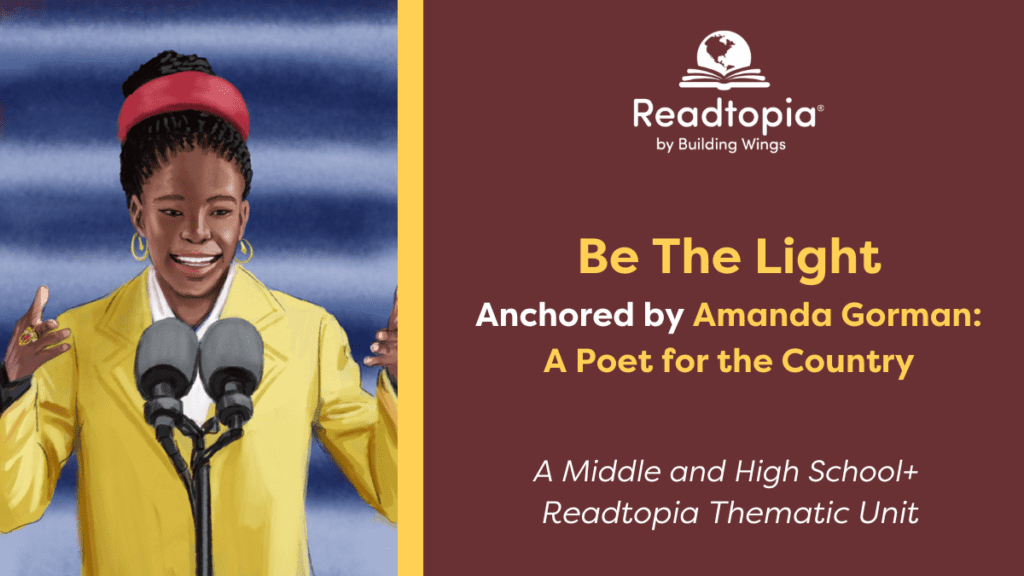
Using age-respectful materials for older learners is critical for sparking interest and increasing engagement. Pairing that with adapted text and explicit phonics instruction enables educators to help students with complex learning profiles soar in literacy learning.
The Readtopia thematic unit Be The Light— Amanda Gorman: A Poet for the Country provides a way for learners to see themselves in the story of a young girl who struggled with speaking to a confident young woman who shone in the national spotlight and provides educators with 6-8 weeks of structured literacy instructional materials using poetry.
“The Hill We Climb” by Amanda Gorman
On Wednesday, January 20, 2021, Amanda Gorman stood before a crowd in Washington, D.C., and read her poem “The Hill We Climb” as the youngest inaugural poet in U.S. history.
Amanda’s story is one of overcoming and perseverance; it has much to teach our learners. They may see themselves in Amanda and her journey as a child in speech therapy. By learning about Amanda’s success and understanding how she achieved it, they may be inspired and encouraged to achieve their own successes and overcome similar adversities.
Alternatively, it gives our learners a window into understanding a life that may look very different from their own.
Engage and Inspire Learners
This unit is anchored in the story of Amanda’s life as a young child with a speech disorder who became a young poet who received a phone call from the First Lady of the United States of America, asking her to speak at a presidential inauguration.
The unit includes everything educators need to provide literacy instruction to learners with a wide range of abilities in middle school through high school+, including an audio recording of Amanda’s story that corresponds to the conventional text set, providing multi-modal ways of learning and engaging with instructional materials.
Learners will see Amanda working hard to overcome her speech challenges. They will learn how she was introduced to poetry through the poet Maya Angelou, and understand how Amanda played with words, putting them together to make poems.
A summary of Amanda’s story is included at the back of each adapted book in this curriculum; this is an example of what is included in the conventional five text.
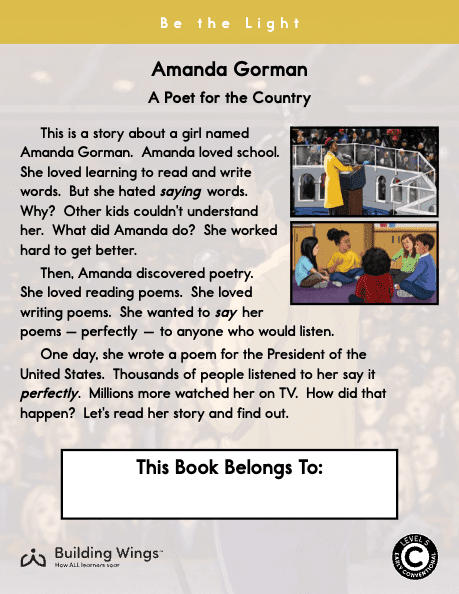
Structured Literacy Instruction for a Wide Range of Learners Using Amanda's Story
“Be the Light” is one of 30+ Readtopia thematic literacy instruction units educators can access to provide structured literacy instruction to a wide range of learners, including older learners. While they learn the story of Amanda Gorman and develop background knowledge about presidential inaugurations and Washington, D.C., they also receive standards-aligned instruction in ELA, and math.
The instructional materials are organized so that a substitute teacher can easily continue with the lesson plan and enable paraprofessionals to support learners and teachers while also providing opportunities for independent work by learners to reinforce and apply learning.
This unit includes:
- A robust Teacher Guide with 324 pages of prompts for providing explicit instruction. These are a few sample pages.
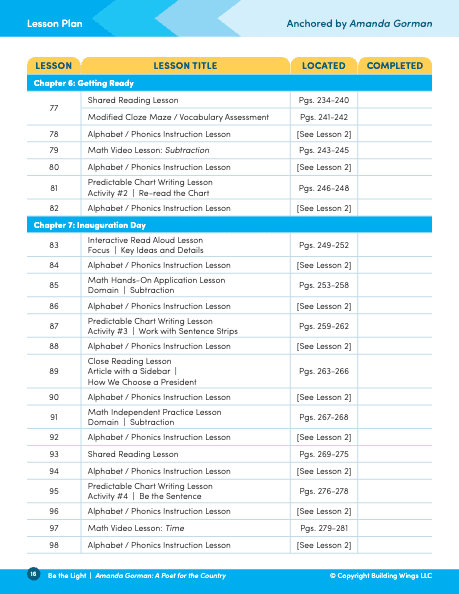
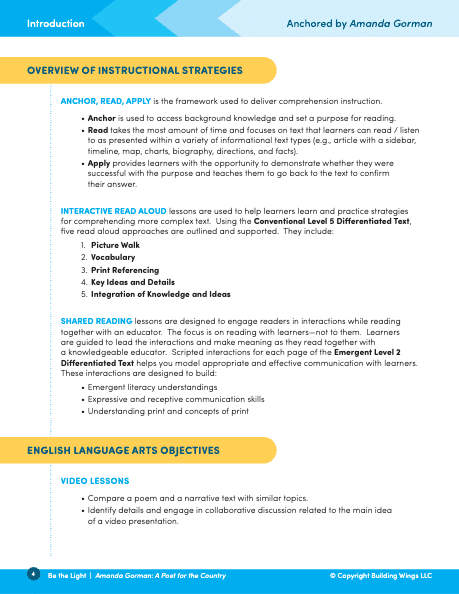
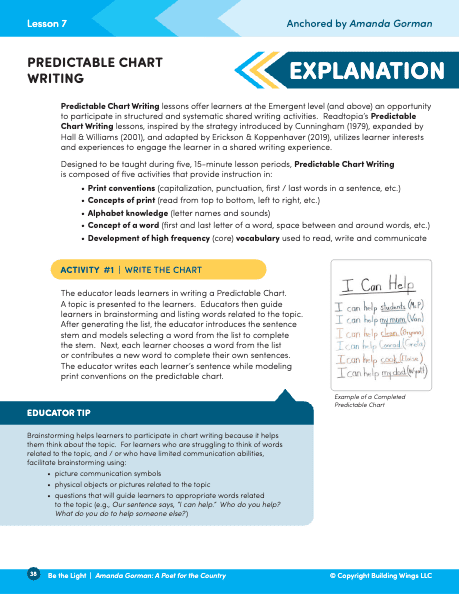
- The story of Amanda Gorman, written at five differentiated text sets to accommodate multi-level learners in the same classroom.
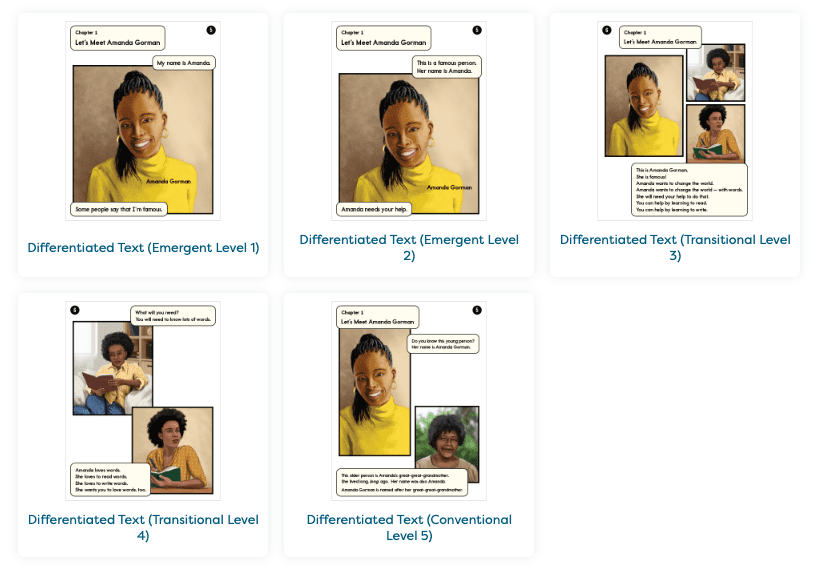
- Videos and visual supports to help learners form mental models and extension activities to engage your learners and reinforce their learning
Teaching Upper Elementary Standards: ELA and Math Objectives
As you work your way through this unit, which includes 112 lessons organized into eight chapters, learners will encounter the following upper elementary standards-aligned objectives:
Informational Text Lessons included in this unit include:
- Ask and answer questions specific to the topic, text, or issue under discussion.
- Determine words and phrases that complete literal sentences in a poem.
- Identify a long-term goal (personal dream) and identify (short-term) goal(s) to reach the long-term goal (make the dream come true).
- Identify details in the text that are related to the theme or central idea.
- Identify details related to the main idea of an informational text.
- Identify details that elaborate upon ideas introduced in a text.
- Identify elements that are characteristics of informational text (maps); Identify map features.
- Identify similarities (and differences) between fiction and nonfiction.
Math objectives included in this unit include:
- Addition: Combine sets and count to add; use single and double-digit numbers for adding.
- Geometry: Identify the same shapes; sort shapes by number of sides or angles.
- Money: Identify the value of money, more and less; counting on.
- Operations & Algebraic Thinking: Use shapes and numbers to create a pattern.
- Subtraction: Separate sets and count to subtract. Use single- and double-digit numbers for subtracting.
- Time: Sequence pictures using before, during, and after; tell time to the hour, half-hour, and minute.
Each objective ties back to Amanda’s story. For example, learners count the books that Amanda loved, explore a map of Washington, D.C., learn about making and publishing a book, and learn about the presidential inauguration.
In addition, explicit phonics lessons are always included throughout every Readtopia unit.
“The ultimate goal is for our students to learn to read. We know that it may take longer, but our goal is to ensure they’re engaged at all times with age-appropriate materials.”
~Mary Krenz.
Overcoming Challenges with SEL Concepts
Throughout this unit, we’re reminded of how Amanda overcame her struggles with encouragement, intervention, and hard work. Her story provides the opportunity to learn about the social-emotional learning (SEL) concepts that help us and our peers overcome challenges.
Through Amanda’s story, learners will better understand a number of SEL concepts, shown below with examples from the text:
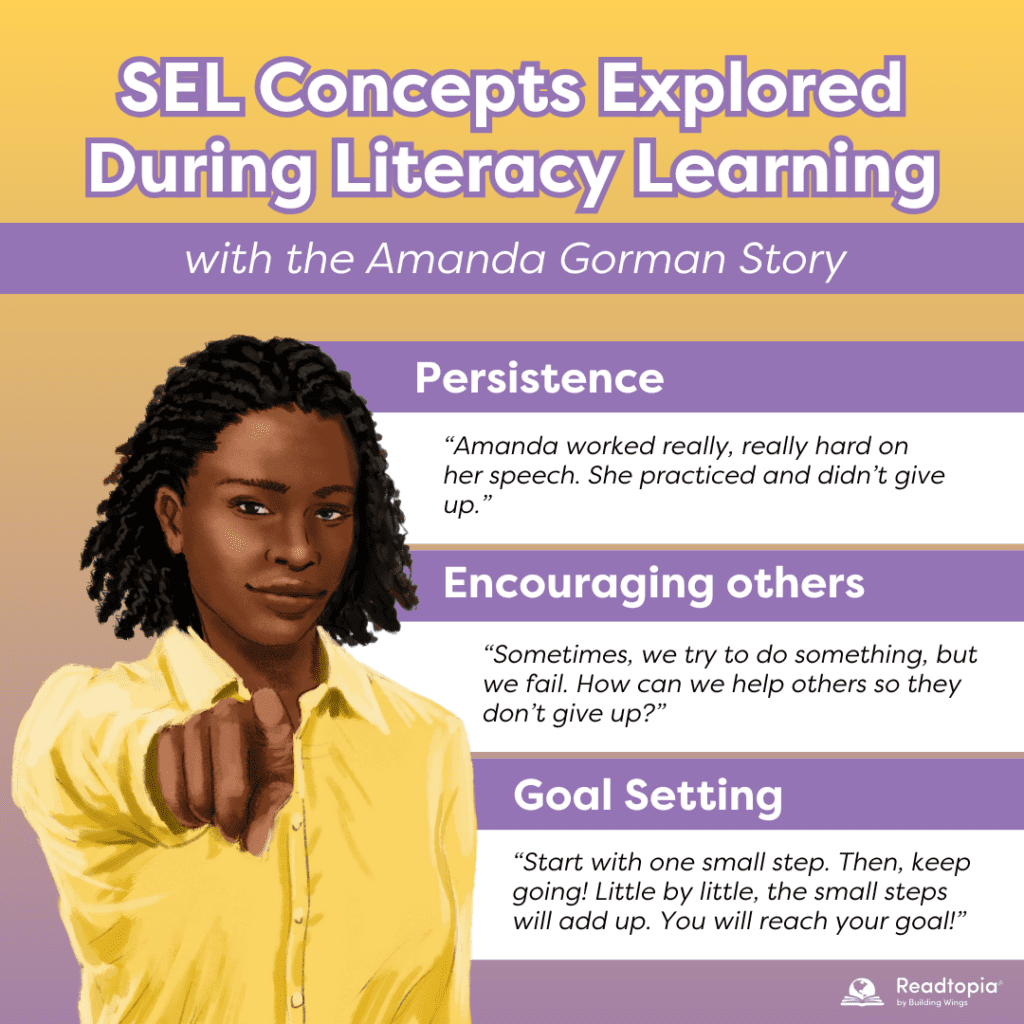
Structured Literacy Instruction for a Wide Range of Learners Using Poetry
Through this unit, learners will experience the art of poetry. A video lesson highlights an exchange in a flower shop, where a customer wants to express to somebody how he feels about them.
The shopkeeper gives this advice:
“A poem is a special way of writing. Usually, you choose words for a poem based on their beauty or their sound. Saying a poem out loud is a great way to share your feelings.”
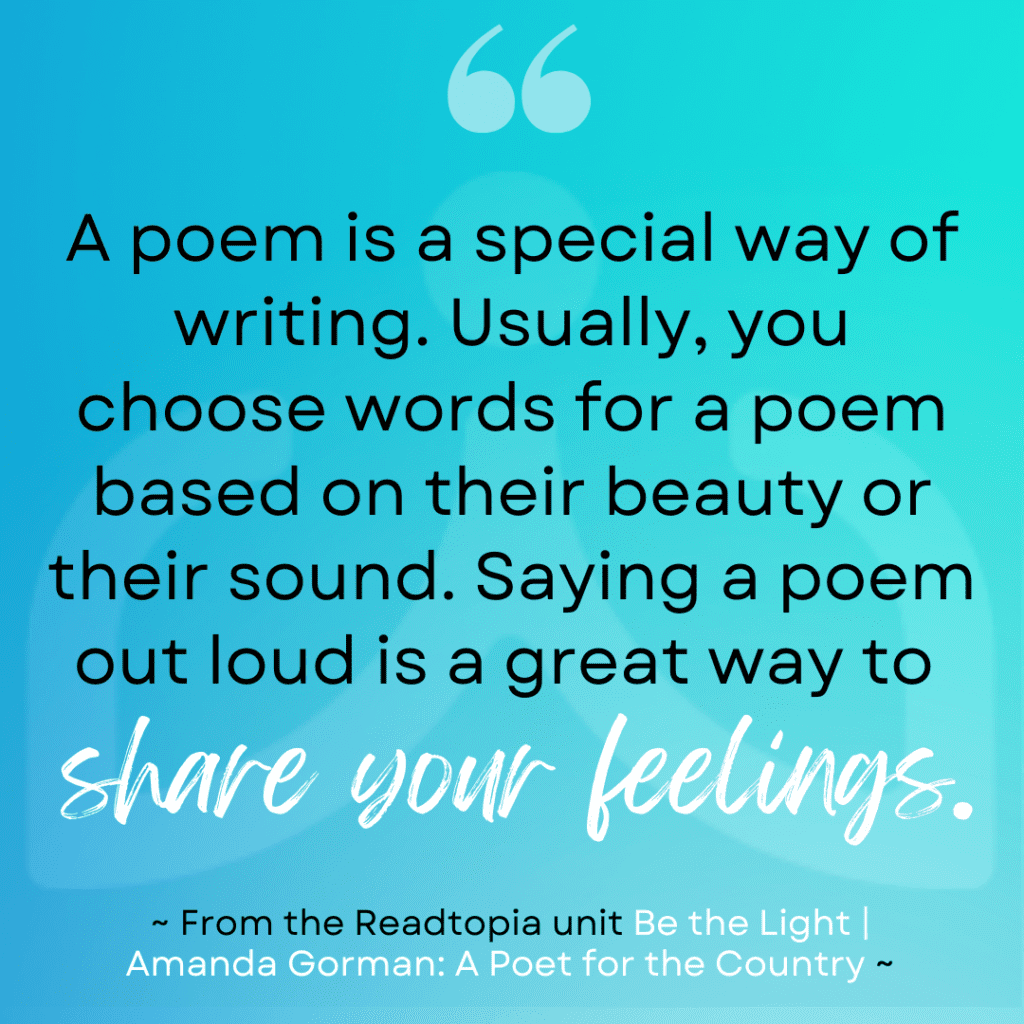
The salesperson then talks about how anyone can write a poem. That includes children like Amanda Gorman, who once struggled to speak but used poetry to express herself and improve her speech.
The following lesson breaks down rhythm and rhyme in an accessible, explicit way by having learners clap along with two additional poems and identify rhyming words.
Our learners can understand that poetry is an art that’s accessible to everyone—including them!
Mary Krenz from the Readtopia development team says, “Many of the students we support face various struggles. Amanda was an ordinary young lady who loved books but also struggled and overcame that struggle.”
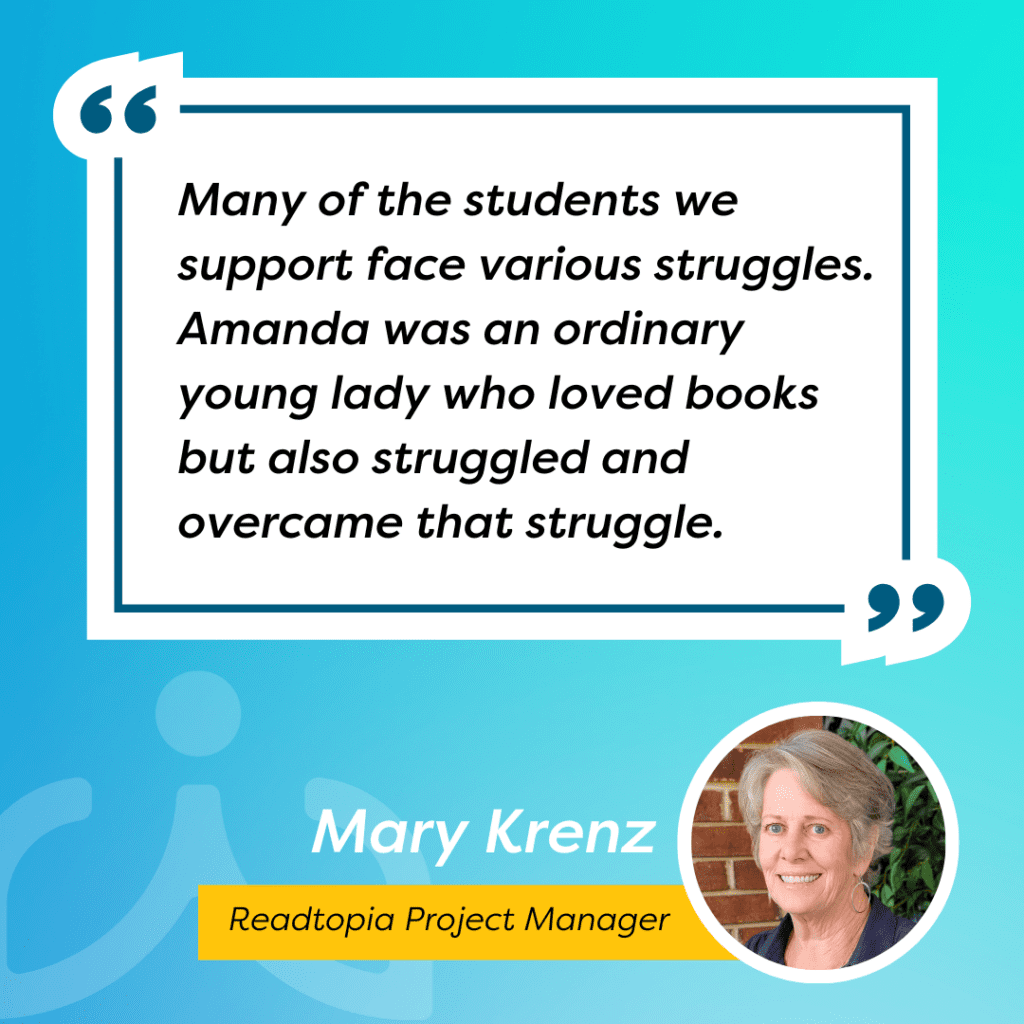
Using Readtopia to Provide Age-Respectful and Structured Literacy Instruction
See the Readtopia page for more information on how this unit and the other 30+ thematic units provide a research-based solution for school districts and adult learning communities searching for time-saving ways to provide engaging, effective, and structured literacy instruction to older learners that is age-respectful and based on the science of reading.

